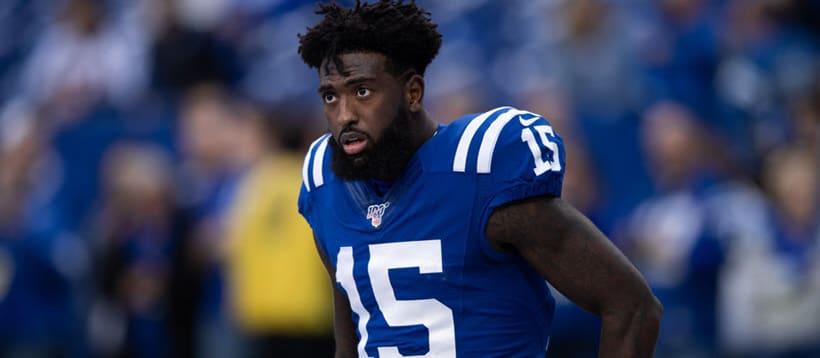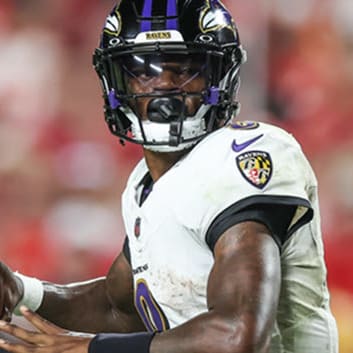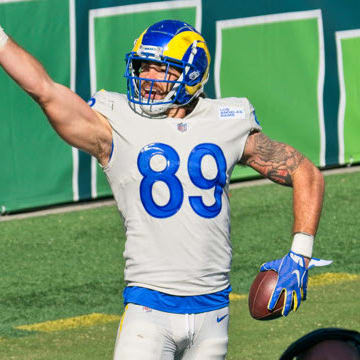This article is part of our Dynasty Strategy series.
This article will look at nine wide receiver prospects and identify which ones should generally be bought, sold, or held in dynasty leagues this offseason. These verdicts are only generally the case – some of them might not apply in all leagues, so just remember to keep the takeaways within what's practical and understand there are exceptions.
Buy
Parris Campbell, WR, IND
The other guys on this list are tempting too, but there might not be a more overlooked dynasty asset to me than Campbell, who everyone seems very much bored of after two injury-wrecked seasons to begin his NFL career. Campbell has had remarkably bad luck, dealing with a sports hernia, broken wrist and broken foot as a rookie before a torn MCL/PCL ended his 2020 season in Week 1. Campbell has thus received the 'injury prone' label even though the nature of his injuries are all freakish. Because his injuries occurred by bad luck they're not likely to portend further injury troubles, meaning we should value Campbell more or less as if he never got hurt, but that's not at all the case with his current market.
The assumption that Michael Pittman is better than Campbell won't age well. Campbell is only three months older than Pittman despite getting drafted two years earlier, and there aren't three better athletes than Campbell at receiver in the entire NFL. At 6-0, 205 Campbell ran a 4.31-second 40 while posting a 40-inch vertical and 135-inch broad jump. Campbell is singularly
This article will look at nine wide receiver prospects and identify which ones should generally be bought, sold, or held in dynasty leagues this offseason. These verdicts are only generally the case – some of them might not apply in all leagues, so just remember to keep the takeaways within what's practical and understand there are exceptions.
Buy
Parris Campbell, WR, IND
The other guys on this list are tempting too, but there might not be a more overlooked dynasty asset to me than Campbell, who everyone seems very much bored of after two injury-wrecked seasons to begin his NFL career. Campbell has had remarkably bad luck, dealing with a sports hernia, broken wrist and broken foot as a rookie before a torn MCL/PCL ended his 2020 season in Week 1. Campbell has thus received the 'injury prone' label even though the nature of his injuries are all freakish. Because his injuries occurred by bad luck they're not likely to portend further injury troubles, meaning we should value Campbell more or less as if he never got hurt, but that's not at all the case with his current market.
The assumption that Michael Pittman is better than Campbell won't age well. Campbell is only three months older than Pittman despite getting drafted two years earlier, and there aren't three better athletes than Campbell at receiver in the entire NFL. At 6-0, 205 Campbell ran a 4.31-second 40 while posting a 40-inch vertical and 135-inch broad jump. Campbell is singularly explosive after the catch and the Colts need him – his value will be significantly higher as soon as October if his durability cooperates, and the hype may very well ramp up before then too once people see Campbell back in practice.
Van Jefferson, WR, LAR
Jefferson isn't a great prospect and the Rams were probably wrong to select him in the second round of the 2020 draft, but he has a good shot at emerging as the WR3 in a Rams offense that's about to improve drastically under Matthew Stafford. Josh Reynolds is both underwhelming as an NFL player and a free agent for the cap-strapped Rams, so it should be a near lock that Jefferson replaces Reynolds as the team's third receiver. Jefferson's upside as a WR3 is of course limited but both Cooper Kupp and Robert Woods have some amount of durability concern and Jefferson could step into the role of either if necessary. But the basic draw with Jefferson is that he should prove a baseline producer and the Rams baseline is about to go way up.
Bryan Edwards, WR, LV
Whereas Jefferson is a mediocre prospect with a great situation, Edwards is a very good prospect whose situation is ambiguous at best. There's no reason to think the Raiders passing game gets especially good anytime soon, and the Raiders depth chart is crowded enough that it's understandable that dynasty leaguers might not see much hope with Edwards, who finished his rookie year with just 193 yards and one touchdown on 15 targets.
Edwards' prospect profile remains strong all the same, and the Raiders passing game might be less crowded than it looks. Nelson Agholor is a free agent, Hunter Renfrow is basically a backup, and Henry Ruggs plays a different, more decoy-oriented position than Edwards does. After Darren Waller the second-most targeted role is up for grabs on this team, and Edwards' prospect profile gives reason to believe he's about to gain a lot of ground. Edwards started as a true freshman at South Carolina and more or less matched the production of the much older Deebo Samuel, and Edwards only turned 22 in November. If the Edwards share owner in your league has lost the faith then it might be worth investing in Edwards even with his playing circumstances uncertain in the meantime.
Quintez Cephus, WR, DET
The Lions will probably add competition in the draft or free agency, but Cephus is a strong bet to emerge as Detroits WR2 in 2021 all the same. All of Kenny Golladay, Marvin Jones, Danny Amendola and Mohamed Sanu are free agents, and the Lions are up enough against the cap that they're unlikely to pay for more than Golladay. Even if Amendola or Sanu is brought back for Detroit's slot specialist role, Cephus' rookie year production and broader prospect profile imply that he'll displace them in the target rotation either way.
Cephus was about 22.5 as a rookie last year and produced quite well, turning 35 targets into 20 receptions for 349 yards and two touchdowns on 365 snaps. That's a catch rate of 57.1 at 10.0 yards per target, which qualifies as above baseline in a Detroit offense that completed 64.3 percent of its passes at 7.6 yards per attempt. Cephus has a good shot at 800 or more snaps in 2021, and if he does it would probably set his over/under for yardage around 725 or so. Cephus was uniquely productive in college and only showed more of the same as a rookie.
Sell
Marquez Valdes-Scantling, WR, GB
Valdes-Scantling leaves it all on the field and was borderline valiant at times for the Packers in 2020, but he's still not good enough for a starting outside receiver and Green Bay will eventually figure that out. Valdes-Scantling would ideally be an off-the-bench outside receiver who works as a decoy and post/fly route threat on a 450-snap role rather than the full-time role the Packers used him in last year, and anyone who's watched the Packers would tell you how noticeably bad Valdes-Scantling's hands are. Every catch is an adventure with him, a fact that shows up in his brutal career catch rate of 50.5 over 192 targets. Valdes-Scantling has sometimes been described as a player with upside because he's big and fast, but with age 27 coming up in October he is almost certainly maxed out in his development. MVS has one year left on his rookie contract, and if he leaves Green Bay his value will turn to zero pretty quick. I'd be worried in the meantime about not just Allen Lazard, but also Devin Funchess.
Russell Gage, WR, ATL
Gage's 2020 season as at once a breakout for the slot specialist and confirmation of his inadequacy. He showed us his best, in other words, but it was still less than what he needed to do to project as a viable starting slot receiver in the NFL. Gage just doesn't catch the ball reliably enough to make him an asset to an offense – even as he caught 72 receptions for 786 yards and four touchdowns on 109 targets in 2020, his catch rate of 66.1 was too low for a player who averaged only 10.9 yards per catch. The Atlanta baseline was 65.0 percent completed at 7.4 yards per attempt, which means Gage's 66.1 percent catch rate at 7.2 yards per target registered slightly below baseline – that catch rate needs to be at least 67 percent, or the YPT needs to be 7.5 or higher.
Through three years Gage has caught 65.8 percent at 6.7 yards per target, which is brutal given that Matt Ryan has generally produced well as a passer over that span. Gage offers neither reliability nor explosiveness, and there's no guarantee the Arthur Smith regime has much use for him.
Michael Pittman, IND
Pittman is a fine player, so his share owners shouldn't feel any true urgency to move him. But there is a fairly prevalent sentiment that Pittman is some sort of potential star, or at the very least the clear WR1 of the future in Indianapolis. The Campbell entry earlier foreshadowed this, but I'm pretty sure those sentiments about Pittman are wrong. This is a classic case of a 50-grade prospect – there's value in a guy you know can start for you every day, even if you wouldn't mistake him for a true standout at his position. But if someone is willing to pay a standout price for Pittman then I would move him in a hurry.
Pittman turned 23 in October, making him as old as most second-year receivers, yet he only produced 503 yards and one touchdown on 699 snaps in 2020. He drew only 0.74 air yards per snap, which ranked 21st percentile, and his YAC per catch (7.1) is unsustainably high. That means his otherwise good looking 8.2 yards per target could regress even if his target volume improves. At USC Pittman was outproduced by 2021 prospect Amon-Ra St. Brown, and before that he was outproduced by non-prospect Deontay Burnett. Pittman can give the Colts useful snaps and he has some value in dynasty formats, but his upside is completely overstated in my opinion.
Hold
Jalen Reagor, WR, PHI
Reagor share owners are in a tough spot because everyone knows a Jalen Hurts offense won't be good for Reagor's target volume, so most of his investors would struggle to sell him for a sufficient return. The right call for Reagor investors is to hold him through the 2021 season if possible, because his value is likely to be higher following the season. If Hurts turns out good, then it gives Reagor a viable way to offset meager target volume with explosive yardage and touchdown potential. If Hurts turns out bad, then the Eagles will likely move on from him in the offseason, allowing Reagor's value to turn back upward under speculation of more pass volume and better pass efficiency from whatever plausible alternative the Eagles might turn to at quarterback.
KJ Hamler, WR, DEN
Listing Hamler here isn't criticism so much as acknowledgment of his formidable competition – Courtland Sutton and Jerry Jeudy both have top-shelf upside at receiver, Tim Patrick was at least an average-quality starter last year, and the Noah Fant/Albert Owkuegbunam tight end duo is more athletic as any other team's. Hamler is especially young for his class and won't turn 22 until July, so he could have quite a bit more developing to do before he catches up to his more polished teammates. That all of these guys are fighting for targets on a team with dubious quarterback play is another concern. The payoff could be significant once Hamler really hits his stride, but anyone buying him right now should prepare for at least another year before any useful returns are reaped. He's mostly a theoretical asset until Patrick leaves at the very least.









